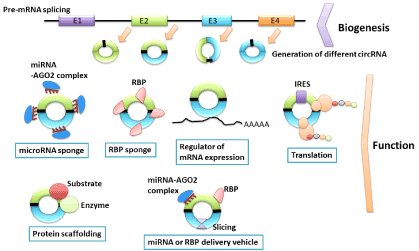Abstract
Circular RNAs (circRNAs) are a class of non-coding RNAs which is being explored recently. CircRNAs are highly conserved across species and exhibit tissue/developmental stage-specific expression. circRNAs are more stable than linear mRNAs and lack a 5′-terminal cap and 3′-terminal poly A tail. CircRNAs modulate gene expression at the transcriptional and post-transcriptional levels. circRNAs play different functional roles in hallmark cancer events both as oncogens and tumor supressors including regulation of angiogenesis, induction of metastasis and invasion, evading cell death. Here, we outlined the molecular mechanisms of circRNA function to regulate the molecular events in cancer. We also reviewed the current knowledge and recent finding regarding the association of circRNA with head and neck cancer. We briefly discussed the potential of circRNA as diagnostic biomarkers as well as the possibility for therapeutic targeting.
Key words
circRNA function, diagnostic biomarkers, hallmark cance, gene expression
Commentary
With rapid advances in molecular biology and unrevealing of human genome and transcriptome, new regulatory roles of non-coding RNA molecules have been identified, and complexity of gene expression dynamics in cancer pathology has been shown. circular-RNAs (cirRNAs) are highly conserved and stable covalently closed RNA circles with gene-regulatory potential [1,2]. Although circular RNA was first described a while ago, until recently they were considered as a byproduct of splicing process with no biological importance. Serval regulatory roles in cancer have been attributed to circRNA [1-3]. Biogenies and function of cirRNAs are depicted in Figure 1. circRNAs can act as miRNA sponges or decoys. miRNA-Ago complex can bind to the cirRNAs, and this interaction may lead to liberating the target mRNAs from miRNA-Ago complex which leads to a more efficient translation. circRNAs can also act as RNA binding protein (RBP) sponge or decoy. Some of circRNAs have binding motifs for both enzyme and their substrates and can enable the kinetics. circRNAs that originate from exon-intron junctions can enhance the transcription of neighboring genes through interaction with U1 snRNP. Splicing and transcription of many genes may also be indirectly regulated through a competition between canonical splicing and back splicing. Some circRNAs have been shown to regulate translation. circRNAs can be genetically modified as delivery vehicle for miRNA-Ago complex or RBP [1-3].

Figure 1. Biogenesis and functions of circular RNA.
It has been evidenced that circRNAs play pivotal roles in regulating proliferation, angiogenesis, evading cellular senescence, and metastasis in cancer [3,4]. Most circRNAs exhibit tissue-specific properties and are stable in biofluids [5]. circRNAs are resistant to RNases and can be detected by probes and quantitative PCRs 1. These characteristics enable them as promising biomarkers for diagnosis and monitoring of different cancers including head and neck cancer. The stability and capacity of circRNA to sponge proteins and mRNAs make them attractive therapeutic vehicles for therapeutic purposes. For instance, specific miRNA and protein binding sites can be specially designed and targeted by circRNA to modulate oncogenic profile.
Recent investigate indicated the dysregulation of circRNA in various forms of head and neck cancer. circRNA_100290 was shown to be overexpressed in oral squamous cell carcinoma compared to the controls and function as a sponge for the miRNA-29 family which leads to the regulation of cell division protein kinase 6 (CDK6) which is one of the master regulators of cancer-induced cell cycle changes [6]. In laryngeal cancer, a significant increase in hsa_circRNA_100855 level is reported in the tumor tissue compared to the healthy tissue 7. Patients with T3 and T4 stage, neck lymph node metastasis or advanced clinical stage showed higher levels of hsa_circRNA_100855 expression 7. The hsa_circRNA_104912 level was significantly lower in laryngeal squamous cell carcinoma than in corresponding adjacent non-neoplastic tissues 7. Patients with T3-4 stage, neck nodal metastasis, poor differentiation or advanced clinical stage had a lower hsa_circRNA_104912 expression [7].
In another study, Verduci et al. [8], using a sample consisted of 115 head and neck squamous cell carcinoma patients, reported that circPVT1 is over-expressed in tumors compared to matched non-tumoral tissues 8. The overexpression was mainly related to TP53 mutation status and was related to a more malignant phenotype. Mechanistically, the circPVT1 expression is transcriptionally increased by the mut-p53/YAP/TEAD complex [8]. circPVT1 modulated the gene involved in cell proliferation [8]. Xia et al. [9] reported overexpression of hsa_circ_0067934 in esophageal cancer cells compared to the adjacent noncancerous tissue samples. The expression levels were related to poor tumor differentiation and late tumor staging and higher involvement of lymph nodes [9].
In conclusion, emerging evidence indicates that circRNAs function as important drivers of cancer. However, this line of research is still emerging. Future studies should focus on mechanistic characterization and causal association of circRNAs in tumorigenesis in head and neck cancer. Parallel with mechanistic studies, well-controlled clinical studies are needed to assess the utility of circRNAs for diagnosis and therapeutic purposes. Based on the recent reports, circRNAs can be as potentially promising candidates not only as a biomarker for cancer diagnosis but also a potential monitoring and therapeutic targets.
Various circular RNAs (circRNAs) can be generated from a same genomic locus. circRNAs are formed by non-canonical splicing process. circRNAs consist of one or more exons and can also have unspliced intronic sequences. Colored bars (exons) black lines (introns). In recent years various roles of circRNAs in cellular processes is arising such as miRNA sponge, RBP sponge, regulator of mRNA expression and translation, protein scaffolding and as delivery vehicles for miRNA-Ago complex or RBP proteins.
Author contributions
FMH and SB both contributed equally to drafting the work. Both authors contributed to concept, writing, and final approval.

